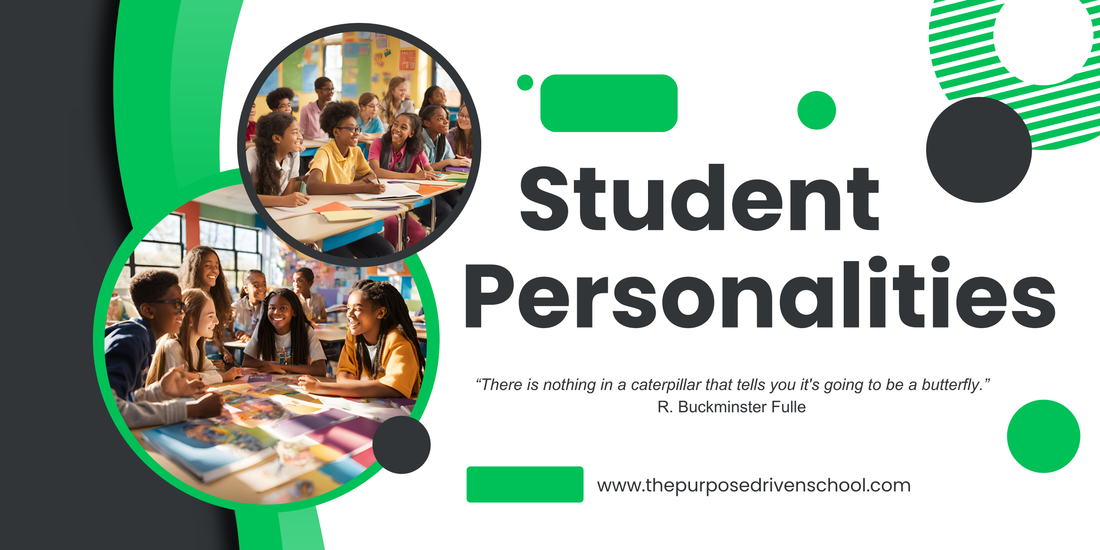By Shawn Brown
Student Personalities: Understanding and Supporting the Diverse Learners in Your Classroom
The classroom is a microcosm of society, filled with students representing a spectrum of personalities, talents, and challenges. As educators, recognizing and supporting these diverse personalities is essential to fostering a thriving learning environment. Below are seven common student personalities you might encounter, along with tips for identifying and supporting them effectively.
1. The Golden Child
Description: This is the student teachers adore. They’re dependable, diligent, and eager to learn. Often seen as a role model, they actively participate in discussions, complete assignments on time, and maintain a positive attitude.
How to Identify: The Golden Child typically excels academically and socially. They are the first to raise their hand, often serve as peer mentors, and might even help enforce classroom rules.
How to Support:
- Challenge them with advanced material to keep them engaged.
- Encourage collaboration to share their strengths without overshadowing peers.
- Provide positive reinforcement without overburdening them with expectations.
2. The Cruiser
Description: The Cruiser is the average student who flies under the radar. They complete the required work but rarely stand out academically or behaviorally.
How to Identify: Their grades are typically average, and they don’t seek attention or recognition. They participate minimally and are content blending into the background.
How to Support:
- Set individualized goals to push them slightly beyond their comfort zone.
- Offer encouragement to help them see their unique potential.
- Check in regularly to ensure they aren’t overlooked.
3. The Lethargian
Description: This student is often mislabeled as lazy, but their lack of engagement may stem from low self-esteem, external stressors, or undiagnosed learning difficulties.
How to Identify: They may seem disinterested, fail to turn in assignments, or put minimal effort into class activities. However, they often show signs of being capable when properly motivated.
How to Support:
- Identify and address any underlying issues, such as learning challenges or personal struggles.
- Break tasks into smaller, manageable steps.
- Use positive reinforcement to acknowledge progress, no matter how small.
4. The Jackhammer
Description: The Jackhammer is disruptive and thrives on creating distractions. They may crack jokes, talk out of turn, or seek attention through negative behavior.
How to Identify: Frequent interruptions, difficulty staying on task, and a tendency to challenge authority are hallmarks of this personality.
How to Support:
- Establish clear boundaries and enforce them consistently.
- Channel their energy into constructive activities, such as leadership roles or hands-on projects.
- Build a rapport to understand their triggers and motivations.
5. The Leper
Description: Socially awkward and often ostracized, this student struggles to navigate social interactions and may feel isolated.
How to Identify: They often sit alone, avoid group activities, and may be the target of teasing or exclusion by peers.
How to Support:
- Foster a culture of inclusion and empathy in the classroom.
- Pair them with kind and supportive peers for group work.
- Provide opportunities for them to shine in areas of strength to build confidence.
6. The Church Mouse
Description: Quiet and reluctant to participate, the Church Mouse avoids drawing attention to themselves and may struggle with confidence or fear of failure.
How to Identify: They rarely speak in class, avoid eye contact, and may appear anxious when called upon.
How to Support:
- Create a safe and encouraging environment where their voice is valued.
- Allow for alternative ways of participation, such as written responses or small-group discussions.
- Gradually increase opportunities for them to engage in low-pressure settings.
7. The Potential
Description: Every student has the potential to become something greater than they are presently. Recognizing and nurturing that potential is the cornerstone of effective teaching.
How to Identify: This is not a single personality but rather a mindset to apply to all students. Look for untapped skills, talents, or interests that could be developed with encouragement.
How to Support:
- Set high but realistic expectations for every student.
- Celebrate growth rather than perfection.
- Build relationships to understand each student’s unique strengths, challenges, and aspirations.
Conclusion
Understanding student personalities allows educators to meet students where they are and guide them toward where they can be. By recognizing the Golden Child’s diligence, the Cruiser’s steadiness, the Lethargian’s hidden potential, the Jackhammer’s energy, the Leper’s need for connection, the Church Mouse’s quiet contributions, and the limitless Potential in every learner, teachers can create an environment where all students thrive.
Remember: The goal isn’t to change these personalities but to nurture each student’s strengths and support their growth, one step at a time.


